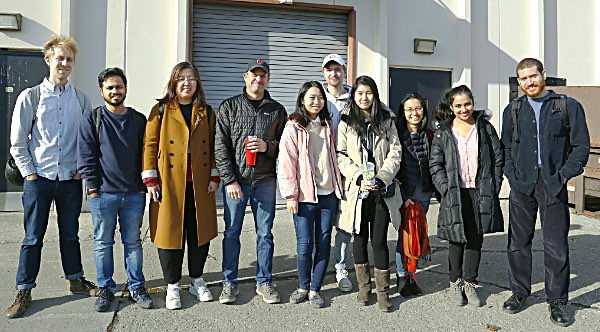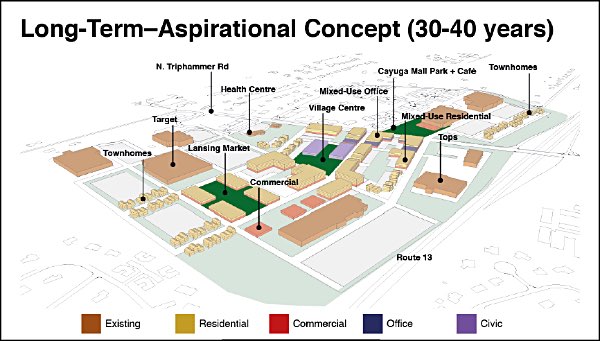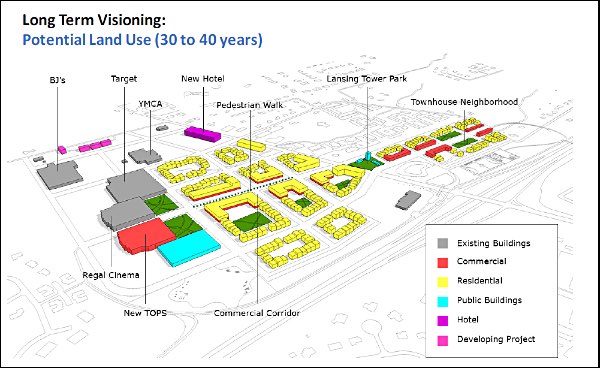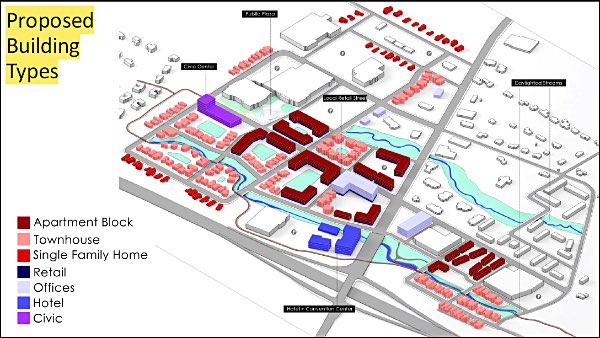- By Ronnie Hardaway
- Around Town
 Print
Print 
Three teams comprising nine Cornell graduate students from the Departments of City & Regional Planning, Architecture, and Landscape Architecture presented their teams' designs and answered questions from attendees. Village trustees and planning board members held a joint meeting on Monday, December 9 to see conceptual presentations for a future Village Center north of the Triphammer Road and NY Route 13 intersection.
The students worked within the Advanced Urban Design Workshop, taught by Mitch Glass, Visiting Lecturer, to research the current facilities, infrastructure, and landscaping around the Shoppes at Ithaca Mall and the Cayuga Mall. After information-gathering, each team created visionary designs of how the area might be transformed into a 'Lansing Village Center' in the next 30 to 40 years.
 Cornell students from the Departments of City & Regional Planning, Architecture, and Landscape Architecture presented their study on short and long-term vision plans for future Lansing Village Centers. Left to right: Quinn Kelly, Akshay Yeleswarapu, Yixuan Li (Team 3); Mitch Glass, instructor; Xinyu He, Nate Revor, Xiuying Zhan (Team 2); Katharine Guan, Akhila Arakkal, Karim Shaltout (Team 1).
Cornell students from the Departments of City & Regional Planning, Architecture, and Landscape Architecture presented their study on short and long-term vision plans for future Lansing Village Centers. Left to right: Quinn Kelly, Akshay Yeleswarapu, Yixuan Li (Team 3); Mitch Glass, instructor; Xinyu He, Nate Revor, Xiuying Zhan (Team 2); Katharine Guan, Akhila Arakkal, Karim Shaltout (Team 1).Glass preceded the teams' presentations with a brief explanation about the goals of the semester-long workshop. He presented the existing strengths and weaknesses of the two malls and the surrounding properties. Strengths included strong regional and national brand stores and active local businesses. Weaknesses of the properties included automobile-oriented retail and restaurants, mall vacancies, declining tax revenue, infrastructure challenges, and excessive parking surfaces.
Glass identified opportunities for change from the workshop, including the amount of open land, TCAT service, proximity to the county airport and local employment, expanding workforce housing, views and landscaping setting, ongoing developments in the Village, desire for walkability and bike-ability, and desire for a Village Center. He offered examples of national suburban mall retrofits and the local, East Hill Plaza development.
He concluded his introduction with the premise of the students' study: "How can current Mall strengths be leveraged in the near-term while envisioning a walkable, bikeable, and livable 'Lansing Village Center' in the next 30 to 40 years?"
Team 1
 Long-term concept drawing by Team 1 focused on walkability and connectivity to surrounding areas.
Long-term concept drawing by Team 1 focused on walkability and connectivity to surrounding areas.Akhila Arakkal presented for Team 1, also comprising Katharine Guan and Karim Shaltout, who focused on leveraging current Mall strengths in the near-term while envisioning a walkable, bikeable, and livable Lansing Village Center in the next 30 to 40 years. After analyzing regional and Village developments and demographics, the team proposed a first-phase 'wellness path' connecting the current malls with paths, trails, and recreational nodes for local walkability.
Using the concept of 'incremental urbanism', in which large-scale development changes are made through smaller, incremental developments, the team proposed phases for reconfiguring streets for better traffic flow and walkability, replacing current structures with mixed-use, retail/residential buildings; adding peripheral townhomes for more population density; and creating new green spaces, an outdoor pop-up market, and public gathering areas.
Team 1 showed their plans for a public, Village-center space with a recreation center, a civic center, an open performance area, and a small pavilion. The team's plans also included an open market area for pop-up or temporary retail, bioswales, and outdoor seating. A small park and café would be added to the current Cayuga Mall area, also.
Team 2
 Long-term scenario from Team 2 focused on creating a long-term Village Center area.
Long-term scenario from Team 2 focused on creating a long-term Village Center area.Team 2, Xinyu He, Nate Revor, and Xiuying Zhan, offered a long-term, incremental redevelopment of the area around the two malls into a new Village Center. The team presented a site analysis and zoning-code analysis proposing that the Village Center could become a gateway to the regional areas surrounding the sites.
Incremental urbanism for short-term changes were proposed to alter and improve existing traffic patterns to ensure pedestrian and bike safety and traffic access. The team also added pop-up retail, plazas, and exhibition spaces; better pedestrian paths; and new covered walkways in the short-term (5 to 10 years).
For their long-term vision (30 to 40 years), Team 2 retained some current commercial buildings and added new streets and pedestrian walkways within the Village Center site. A new commercial corridor was created to increase the population density with some retail located on the ground floor of multi-floor, mixed-use buildings, and new apartment complexes around the mixed-use buildings. Stand-alone commercial buildings were reconfigured within other residential buildings, and new public spaces and greenway spaces were added to the development areas. Team 2 also proposed a unique Lansing Tower and park as a landmark for the proposed Village Center.
Team 3
 Long-term vision from Team 3 including daylighted streams and a pedestrian tunnel.
Long-term vision from Team 3 including daylighted streams and a pedestrian tunnel.Team 3, Quinn Kelly, Akshay Yeleswarapu, and Yixuan Li, wrapped up the student presentations with their vision of the Lansing Village Center to incrementally transform the Ithaca and Cayuga Malls over the next 50 years into a walkable, connected mixed-use center for the Village of Lansing. Their Village Center would provide needed workforce, student, and senior housing while preserving and building upon existing commercial uses.
Again, incremental-urbanism, short-term changes introduced artistically painted sidewalks, surfaces, and curbs; creating a rain garden and a children's play space near the Shoppes at Ithaca mall; creating and linking bikeways and pedestrian spaces; and developing a public area near the mall's front parking lot with tiered seating, a basketball court, food-truck spaces, and a market space for temporary retail.
Long-term development in the Team 3 presentation offered reconfiguration of the area's roadways for improved traffic and pedestrian access and increasing the population density within the Village Center. Approximately 850 dwelling units would be added through a mixture of single-family homes, duplexes, triplexes, townhomes and apartments.
Two unusual features of Team 3's vision included "daylighting" the existing streams that are now buried in the developed area. Opening the streams would add attractive greenway/waterway spaces and would help with stormwater management. The second unusual feature was a pedestrian tunnel running beneath Triphammer Road near to and parallel with Route 13.
After the workshop's presentations, members of the Village boards praised the students for their work and visions and had questions and comments about the teams' ideas. One team had suggested that the Village's current zoning laws lacked 'diversity'. Lisa Schleelein, planning board chair, asked for clarification on that observation which led to a discussion on how zoning laws might be made more flexible as to building heights, required parking spaces, and setbacks.
Village trustees were impressed with the visions of the students but noted that it would be a challenge to come up with the budgets to implement them. This opened a discussion on incremental changes, the status of current properties, and the Village tax base. It was noted that another Cornell study focused on the current marketing strategy for the existing properties, and Mr. Glass promised to provide contact information for that study's findings.
v15i46



